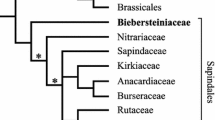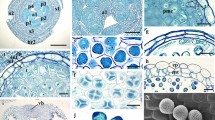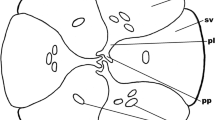Abstract
The embryology of the genus Hemerocallis L. was studied to re-evaluate its current systematic position proposed by recent phylogenies based on molecular data. Using the improved carbol fuchsin–aniline blue staining method and conventional paraffin sectioning technique, we followed the development of anther and pollen grain, ovule and female gametophyte, and embryo and endosperm up to seed maturity. Our results showed that the (1) anther wall development is of the Monocot type, with a one cell-thick middle layer and a secretory tapetum, (2) microsporocytes cytokinesis is of the intermediate type, (3) microspore tetrads are tetragonal or decussate, (4) pollen grains are two-celled, (5) ovary is superior and trilocular, with axile placentas bearing two collateral ovules per locule, (6) ovules are anatropous, tenuinucellate, and bitegmic, with micropyle formed by the inner integument, (7) megaspore tetrads are linear, and only the chalazal one is functional, (8) embryo sac development is typically of Polygonum type, (9) embryogenesis is of Graminad type, and (10) endosperm development is of nuclear type. Overall, our study thus confirms that the embryological features of Hemerocallis support its exclusion from Liliaceae in Liliales, its inclusion in Asparagales, and its affinities with Asphodelaceae.




Similar content being viewed by others
References
Ahmad NM, Martin PM, Vella JM (2008) Embryology of the dioecious Australian endemic Lomandra longifolia (Lomandraceae). Austral J Bot 56:651–665. doi:10.1071/BT07222
APG (1998) An ordinal classification for the families of flowering plants. Ann Missouri Bot Gard 85:531–553. doi:10.2307/2992015
APGII (2003) An update of the Angiosperm Phylogeny Group classification for the orders and families of flowering plants: APG II. Bot J Linn Soc 141:399–436. doi:10.1046/j.1095-8339.2003.t01-1-00158.x
APGIII (2009) An update of the Angiosperm Phylogeny Group classification for the orders and families of flowering plants: APG III. Bot J Linn Soc 161:105–121. doi:10.1111/j.1095-8339.2009.00996.x
APGIV (2016) An update of the Angiosperm Phylogeny Group classification for the orders and families of flowering plants: APG IV. Bot J Linn Soc 181:1–20. doi:10.1111/boj.12385
Arekal GD (1967) Contribution to the embryology of Hypoxis aurea Lour. J Indian Bot Soc 46:193–198
Arekal GD, Karanth KA (1981) The embryology of Epipogium roseum (Orchidaceae). Pl Syst Evol 138:1–7. doi:10.1007/BF00984604
Ashurmetov OA, Yengalycheva SS, Fritsch RDM (2001) Morphological and embryological characters of three middle Asian Allium L. species (Alliaceae). Bot J Linn Soc 137:51–64. doi:10.1111/j.1095-8339.2001.tb01104.x
Aybeke M (2012) Anther wall and pollen development in Ophrys mammosa L. (Orchidaceae). Pl Syst Evol 298:1015–1023. doi:10.1007/s00606-012-0610-z
Bachelier JB, Endress PK (2009) Comparative floral morphology and anatomy of Anacardiaceae and Burseraceae (Sapindales), with a special focus on gynoecium structure and evolution. Bot J Linn Soc 159:499–571. doi:10.1111/j.1095-8339.2009.00959.x
Bachelier JB, Endress PK, Ronse De Craene LP (2011) Comparative floral structure and development of Nitrariaceae (Sapindales) and systematic implications. Cambridge University Press, Cambridge, pp 181–217. doi:10.5167/uzh-57594
Batygina TB (1969) On the possibility of separation of a new type of embryogenesis in angiospermae. Rev Cytol Biol Vég 32:335–341
Berg RY (2009) Embryo sac, endosperm, and seed of Nemophila (Boraginaceae) relative to taxonomy, with a remark on embryogeny in Pholistoma. Amer J Bot 96:565–579. doi:10.3732/ajb.0800208
Bouman F (1984) The ovule. In: Johri BM (ed) Embryology of angiosperms. Springer, Berlin, Heideberg, pp 123–157
Brown RC, Lemmon BE, Nguyen H, Olsen OA (1999) Development of endosperm in Arabidopsis thaliana. Sex Pl Reprod 12:32–42. doi:10.1007/s004970050169
Brown RC, Lemmon BE, Nguyen H (2002) The microtubule cycle during successive mitotic waves in the syncytial female gametophyte of ginkgo. J Pl Res 115:491–494. doi:10.1007/s10265-002-0056-4
Brummitt RK, Banks H, Johnson MAT, Docherty KA, Jones K, Chase MW, Rudall PJ (1998) Taxonomy of the Cyanastroideae (Tecophilaeaceae): a multidisciplinary approach. Kew Bull 53:769–803. doi:10.2307/4118869
Caparelli KF, Peruzzi L, Cesca G (2006) A comparative analysis of embryo-sac development in three closely-related Gagea species (Liliaceae), with some considerations on their reproductive strategies. Pl Biosystems 140:115–122. doi:10.1080/11263500600756090
Chen XQ, Junko N (2000) Hemerocallis Linnaeus. In: Wu ZY, Raven PH (eds) Flora of China, vol 24. Science Press and Missouri Botanical Garden Press, Beijing and New York, pp 161–165
Chen HN, Zhao CH, Liu XR, Liu JX (2012) Pollen development of Cardiocrinum giganteum (Wall.) Makina in China. Pl Syst Evol 298:1557–1565. doi:10.1007/s00606-012-0658-9
Chichiriccò G (1989) Embryology of Crocus thomasii (Iridaceae). Pl Syst Evol 168:39–47. doi:10.1007/BF00936105
Conran JG, Temby A (2000) Embryology and affinities of the Boryaceae (Asparagales). In: Wilson KL, Morrison DA (eds) Monocots: Systematics and Evolution. CSIRO, Melbourne, pp 401–406
Cronquist A (1981) An integrated system of classification of flowering plants. Columbia University Press, New York
Czapik R, Izmailow R (2001) Zygotic embryogenesis, structural aspects. In: Bhojwani SS, Soh WY (eds) Current trends in the embryology of angiosperms. Kluwer Academic Publishers, Dordrecht, pp 197–222. doi:10.1007/978-94-017-1203-3
Dahlgren RMT, Clifford HT, Yeo PF (1985) The families of the monocotyledons: structure, evolution and taxonomy. Springer, Berlin. doi:10.1007/978-3-642-61663-1
Davis GL (1966) Systematic embryology of the angiosperms. John Wiley and Sons, New York
Di Fulvio TE, Cave MS (1964) Embryology of Blandfordia nobilis Smith (Liliaceae), with special reference to its taxonomic position. Phytomorphology 14:487–499
Dulberger R, Ornduff R (1980) Floral morphology and reproductive biology of four species of Cyanella (Tecophilaeaceae). New Phytol 86:45–56. doi:10.1111/j.1469-8137.1980.tb00778.x
Ekici N (2014) Microsporogenesis, pollen mitosis and pollen tube growth in Gagea villosa (Liliaceae). Biologia 69:1323–1330. doi:10.2478/s11756-014-0439-8
Endress PK (2011) Angiosperm ovules: diversity, development, evolution. Ann Bot (Oxford) 107:1465–1489. doi:10.1093/aob/mcr120
Endress PK, Doyle JA (2009) Reconstructiong the ancestral flower and ite initial specializations. Amer J Bot 96:22–66. doi:10.3732/ajb.0800047
Endress PK, Doyle JA (2015) Ancestral traits and specializations in the flowers of the basal grade of living angiosperms. Taxon 64:1093–1116. doi:10.12705/646.1
Endress PK, Igersheim A (2000) Gynoecium structure and evolution in basal angiosperms. Int J Pl Sci 161:S211–S223. doi:10.1086/317572
Fahn A (1954) The anatomical structure of the Xanthorrhoeaceae Dumort. Bot J Linn Soc 55:158–184. doi:10.1111/j.1095-8339.1954.tb00009.x
Fredrikson M (1991) An embryological study of Platanthera bifolia (Orchidaceae). Pl Syst Evol 174:213–220. doi:10.1007/BF00940341
Furness CA, Rudall PJ (1998) The tapetum and systematics in monocotyledons. Bot Rev 64:201–239. doi:10.1007/BF02856565
Furness CA, Rudall PJ (1999) Microsporogenesis in monocotyledons. Ann Bot (Oxford) 84:475–499. doi:10.1006/anbo.1999.0942
Furness CA, Rudall PJ (2000) The systematic significance of simultaneous cytokinesis during microsporogenesis in monocotyledons. In: Wilson KL, Morrison DA (eds) Monocots: Systematics and Evolution. CSIRO, Melbourne, pp 189–193
Furness CA, Rudall PJ (2001) Pollen and anther characters in monocot systematics. Grana 40:17–25. doi:10.1080/00173130152591840
Goldblatt P, Rodriguez A, Powell MP, Davies TJ, Manning JC, Van der Bank M, Savolainen V (2008) Iridaceae ‘out of Australasia’? Phylogeny, biogeography, and divergence time based on plastid DNA sequences. Syst Bot 33:495–508. doi:10.1600/036364408785679806
Haig D (1986) Conflicts among megaspores. J Theor Biol 123:471–480. doi:10.1016/S0022-5193(86)80214-4
Haig D (1990) New perspectives on the angiosperm female gametophyte. Bot Rev 56:236–274. doi:10.1007/BF02858326
Hu SY (2005) Reproductive biology of angiosperms. China Higher Education Press, Beijing
Johri BM (1963) Female gametophyte. In: Maheshwari P (ed) Recent advances in the embryology of angiosperms. International Society of Plant Morphologists, University of Delhi, Delhi, pp 69–103
Johri BM (1984) Embryology of angiosperms. Springer, Berlin. doi:10.1007/978-3-642-69302-1
Johri BM, Ambegaokar KB, Srivastava PS (1992) Comparative embryology of angiosperms. Springer, Berlin. doi:10.1007/978-3-642-76395-3
Kocyan A, Endress PK (2001) Floral structure and development and systematic aspects of some ‘lower’ Asparagales. Pl Syst Evol 229:187–216. doi:10.1007/s006060170011
Lakshmanan KK, Philip VJ (1971) A Contribution to the embryology of Iridaceae. Proc Indian Acad Sci B 71:110–116. doi:10.1007/BF03045310
Li ZL (1978) The technology of making sections in plant tissues. Science Press, Beijing
Li L, Liang HX, Peng H, Lei LG (2003) Sporogenesis and gametogenesis in Sladenia and their systematic implication. Bot J Linn Soc 143:305–314. doi:10.1046/j.1095-8339.2003.00237.x
Liu JX, Zhang J, Liu HJ, Wang M, Chen ZK, Xi YZ (2011) Anther structure and pollen ontogeny of Hosta Tratt. and its systematic significance. Pl Syst Evol 297:253–260. doi:10.1007/s00606-011-0514-3
Maheshwari P (1950) An introduction to the embryology of angiosperms. McGraw-Hill Book Company, New York
Nadot S, Forchioni A, Penet L, Sannier J, Ressayre A (2006a) Links between early pollen development and aperture pattern in monocots. Protoplasma 228:55–64. doi:10.1007/s00709-006-0164-4
Nadot S, Penet L, Dreyer LD, Forchioni A, Ressayre A (2006b) Aperture pattern and microsporogenesis in Asparagales. Aliso 22:195–201
Nadot S, Furness CA, Sannier J, Penet L, Triki-Teurtroy S, Albert B, Ressayre A (2008) Phylogenetic comparative analysis of microsporogenesis in angiosperms with a focus on monocots. Amer J Bot 95:1426–1436. doi:10.3732/ajb.0800110
Newman IV (1929) The life history of Doryanthes excelsa Part II. The gametophytes, seed production, chromosome number, and general conclusion. Proc Linn Soc New South Wales 54:411–435
Penet L, Nadot S, Ressayre A, Forchioni A, Dreyer L, Gouyon PH (2005) Multiple developmental pathways leading to a single morph: monosulcate pollen (examples from the Asparagales). Ann Bot (Oxford) 95:331–343. doi:10.1093/aob/mci030
Penet L, Laurin M, Gouyon PH, Nadot S (2007) Constraints and selection: insights from microsporogenesis in Asparagales. Evol & Developm 9:460–471. doi:10.1111/j.1525-142X.2007.00183.x
Piven NM, Barredo-Pool FA, Borges-Argáez IC, Herrera-Alamillo MA, Mayo-Mosqueda A, Herrera-Herrera JL, Robert ML (2001) Reproductive biology of henequen (Agave fourcroydes) and its wild ancestor Agave Angustifolia (Agavaceae). I. Gametophyte development. Amer J Bot 88:1966–1976
Prosina M (1930) Embryologische untersuchungen an Eremurus spectabilis M. B. Var. Regeli. Planta 9:748–759. doi:10.1007/BF01913446
Rabiya I, Chen ZK, Zhou F, Zhang JH (1995) Studies on embryology of Eremurus anisopterus (Liliaceae). J Xinjiang Univ (Nat Sci Ed) 12:79–84
Ressayre A, Dreyer L, Triki-Teurtroy S, Forchioni A, Nadot S (2005) Post-meiotic cytokinesis and pollen aperture pattern ontogeny: comparison of development in four species differing in aperture pattern. Amer J Bot 92:576–583. doi:10.3732/ajb.92.4.576
Rodriguez-Enriquez MJ, Grant-Downton RT (2013) A new day dawning: Hemerocallis (daylily) as a future model organism. AoB Plants 5:1–15. doi:10.1093/aobpla/pls055
Rudall PJ (1994) The ovule and embryo sac in Xanthorrhoeaceae sensu lato. Flora 189:335–351
Rudall PJ, Furness CA, Chase MW, Fay MF (1997) Microsporogenesis and pollen sulcus type in Asparagales (Lilianae). Canad J Bot 75:408–430. doi:10.1139/b97-044
Sato S (1985) A cytochemical study of the embryo sac formation in Hemerocallis middendorffii var. esculenta (Koidz.) ohwi. Jap J Genet 60:53–61. doi:10.1266/jjg.60.53
Schnarf K, Wunderlich R (1939) Zur vergleichenden embryologie der Liliaceae-Asphodeloideae. Flora 33:297–327
Shi CY, Zhao YY, Chen D, Chen HN, Liu JX (2015) Genesis of megaspore and microspore as well as development of female gametophyte and male gametophyte in Liriope spicata (Thunberg) Loureiro. Pl Syst Evol 301:139–149. doi:10.1007/s00606-014-1060-6
Sood SK (1992) Embryology of Malaxis saprophyta, with comments on the systematic position of Malaxis (Orchidaceae). Pl Syst Evol 179:95–105. doi:10.1007/BF00938022
Sood SK, Mohana Rao PR (1988) Studies in the embryology of the diandrous orchid Cypripedium cordigerum (Cypripedieae, Orchidaceae). Pl Syst Evol 160:159–168. doi:10.1007/BF00936043
Stace CA (1991) Plant taxonomy and biosystematics. Cambridge University Press, Cambridge
Straley GB, Utech FH (2002) Hemerocallis Linnaeus. In: Flora of North America Editorial Committee (eds) Flora of North America, vol 26, Oxford University Press, Oxford, pp 219–220
Svoma E, Greilhuber J (1989) Systematic embryology of the Scilla siberica alliance (Hyacinthaceae). Nordic J Bot 8:585–600. doi:10.1111/j.1756-1051.1989.tb01733.x
Takhtajan AL (1991) Evolutionary trends in flowering plants. Columbia University Press, New York. doi:10.2307/1312093
Tang Y, Gao H, Xie JS (2009) An embryological study of Eriolaena candollei Wallich (Malvaceae) and its systematic implications. Flora 204:569–580. doi:10.1016/j.flora.2008.09.002
Toghranegar Z, Nadot S, Albert B (2013) Variation of microsporogenesis in monocots producing monosulcate pollen grains. Ann Bot (Oxford) 112:135–139. doi:10.1093/aob/mct104
Vardar F, İsmailoğlu I, Ünal M (2012) Embryological and cytological features of Gagea bohemica (Liliaceae). Turkish J Bot 36:462–472. doi:10.3906/bot-1107-11
Wang ZF, Ren Y (2007) Advances in the Study of the Angiosperm Ovule. Chin Bull Bot 24:49–59
Wang M, Wan L, Chen H, Liu X, Liu J (2012) A new fluorescent staining method for callose of microspore mother cells during meiosis. Biotech Histochem 87:300–302. doi:10.3109/10520295.2011.649784
Watson L, Dallwitz MJ (1992) The families of flowering plants: descriptions, illustrations, identification, and information retrieval. Version: 11th May 2015
Willemse MTM, Van Went JL (1984) The female gametophyte. In: Johri BM (ed) Embryology of angiosperns. Springer, Berlin, pp 159–196. doi:10.1007/978-3-642-69302-1_4
Winiarczyk K, Kosmala A (2009) Development of the female gametophyte in the sterile ecotype of the bolting Allium sativum L. Sci Hort (Amsterdam) 121:353–360. doi:10.1016/j.scienta.2009.02.014
Yamada T, Tobe H, Imaichi R, Kato M (2001) Developmental morphology of the ovules of Amborella trichopoda (Amborellaceae) and Chloranthus serratus (Chloranthaceae). Bot J Linn Soc 137:277–290. doi:10.1111/j.1095-8339.2001.tb01123.x
Zhang D, Zhuo LH, Shen XH (2010) Sporogenesis and gametogenesis in Agapanthus praecox Willd. orientalis (Leighton) Leighton and their systematic implications. Pl Syst Evol 288:1–11. doi:10.1007/s00606-010-0280-7
Zhang D, Wang L, Zhuo LH (2011) Embryology of Iris mandshurica Maxim. (Iridaceae) and its systematic relationships. Pl Syst Evol 293:43–52. doi:10.1007/s00606-011-0427-1
Zhang J, Liu XR, Zhang FX, Liu JX (2012a) Microsporogenesis and development of The male gametophyte in Allium senescens L. (Liliaceae) in China. Pl Syst Evol 298:1619–1624. doi:10.1007/s00606-012-0663-z
Zhang XH, Ren Y, Tian XH (2012b) Microsporogenesis and megasporogenesis in Sinofranchetia (Lardizabalaceae). Flora 207:197–202. doi:10.1016/j.flora.2012.01.005
Zhou RC, Liu BR (2000) The anatomic studies on the development of the embryo sac of Hemerocallis fulva. J Xiangtan Normal Univ 21:93–95
Zuo YJ, Ma M (2014) Megasporogenesis, microsporogenesis and development of female and male gametophyte of Eremurus inderiensis (M. Bieb) Regel. Seed 33:21–29
Acknowledgements
This work was supported by the National Natural Science Foundation of China (Grant Nos. 31270276 and 30470106).
Author information
Authors and Affiliations
Corresponding author
Ethics declarations
Conflict of interest
The authors declare that they have no conflict of interest.
Additional information
Handling editor: Yannick Marc Staedler.
Rights and permissions
About this article
Cite this article
Yan, D., Wang, LJ., Zhao, CH. et al. Embryology of Hemerocallis L. and its systematic significance. Plant Syst Evol 303, 663–673 (2017). https://doi.org/10.1007/s00606-017-1398-7
Received:
Accepted:
Published:
Issue Date:
DOI: https://doi.org/10.1007/s00606-017-1398-7




